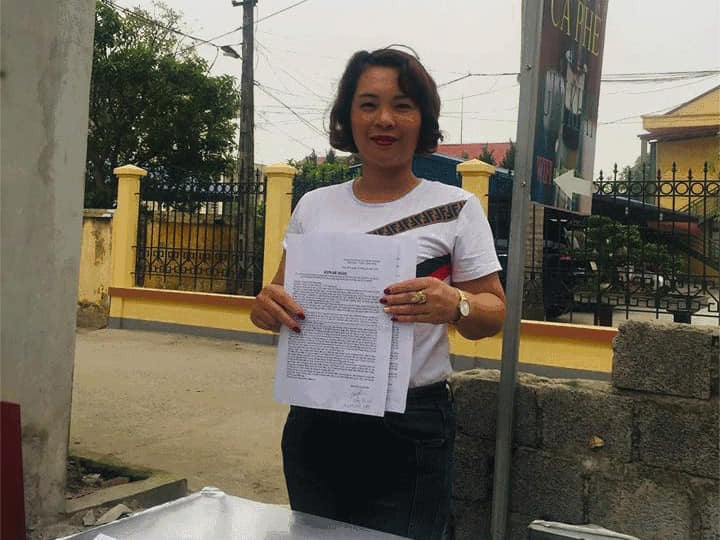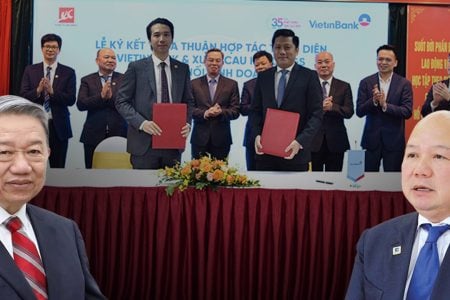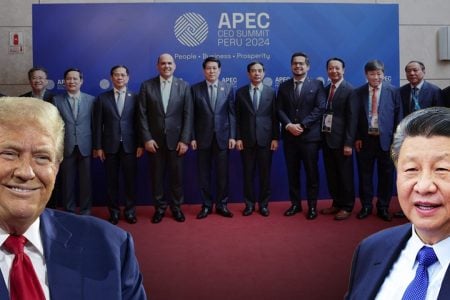
While suppressive trials against anti-BOT activists are still being held in many localities, the state-controlled media reported on July 9 that shocked everyone: the cost of transportation for goods from Ho Chi Minh City to Ha Noi is twice as high as shipping goods to the US.
„Because the three main issues: the first called ‚chung-chi‘ or bribery gave to traffic police, the second is road fees given to the BOT toll booths, and the third is the cost of gasoline,“ said one businessman, but he did not want to name because he was afraid of the government.
Among 10 people sentenced to prison for fighting dirty BOT, Ms. Dang Thi Hue (Facebooker Huệ Như) was given the worst imprisonment of 42 months. Before being arrested, she was kicked by policemen to her belly and the assault led to a miscarriage. She was detained and charged with “causing public disorder” and later the Soc Son district People’s Court convicted her. To date, 19 people have been held in prison for fighting against dirty BOTs across the country.
One of the important reasons for transportation costs in Vietnam is higher than the world is because „there are many toll stations (BOT) from North to South,“ an article in HCM City Law newspaper said on July 10.
Specifically, the newspaper quoted Mr. Le Van Quang, Chairman of the Board of Directors of Minh Phu Group: “Currently, transporting a container from Vietnam to the US costs about VND41 million ($1,759), to Japan costs VND16 million. But the paradox is that the same container, transporting from Saigon to Hanoi takes VND80 million, which is many times higher than international shipping. Similarly, transporting a container from Ca Mau to Saigon costs VND18 million.”
Also according to this newspaper, currently preparing costs are accounting for 29.5% of agricultural production, especially products such as vegetables. Of this spending, transportation costs account for 60%.
In another development, Voice of Vietnam (VOV) newspaper in mid-May said that BOT investors „are having a lot of difficulties when they have to supplement funding to repay bank loans as planned“ while they have not been increased fees according to the roadmap in the BOT contract under the direction of the Vietnamese government to stabilize the macroeconomy.
This quote quoted Mr. Khuong Kim Tao, former deputy chief of staff of the National Traffic Safety Committee: “In the BOT contract, there will be provisions to adjust the difficult issues and problems arising in the process. implementation. However, the adjustment to the direction of raising toll prices is not stable and unreasonable. By raising the price, it will lead to transport costs and the products will team up, the people are still the payers. While we are helping people to recover the economy.”
For a long time, the public has speculated that behind the establishment of each BOT station in Vietnam is the „group interest“ of the Ministry of Transport, the local authorities and businesses are the „backyard“ of the leadership. Drivers when passing through these stations have no other choice but to obediently pay the fees because if they object, they will be accused of “disturbing public order” by the Vietnamese authorities.
Up to now, there have been about 10 citizens participating in the fight against „dirty“ BOTs who had to pay the price by being sentenced to imprisonment: Mr. Ha Van Nam was sentenced to 2 and a half years in prison, Ms. Dang Thi Hue- 3 and a half years in prison, Mr. Bui Manh Tien- 1 year and 3 months in prison, Mr. Van Ngoc Hoang- 1 and a half years in prison … After suppressing the struggle, the Vietnamese communist authorities published a draft Law on Road Traffic amendment that aims at giving BOT stations the right to „charge a lifetime, including the expired projects.“

Because „getting rich is not difficult“ in the style of getting money from drivers, BOT stations are recorded „growing like mushrooms after rain.“ Thanh Nien newspaper in April 2019 said that only a poor province like Binh Phuoc had nine BOT stations.
“Every product manufactured in Binh Phuoc from the input, the output must be charged 24 times when traveling from Binh Phuoc through Binh Duong to Saigon and vice versa. Specifically, businesses that import goods must go through six charging stations to pay up to 12 times (go and return). Goods that are finished and sent for consumption are charged another 12 times,” the newspaper reported.
Facebooker Pham Minh Vu commented on his personal page: “For many years the government of Vietnam has been unable to solve the problem of why goods coming to the US are cheaper than the domestic ones because the BOT toll booths were set up by state officials or backed by them and they take trillions of dong from drivers to put in their pockets. In addition, the container drivers must also give bribery to traffic policemen. Of course, all the fees and bribery are included in the shipping price, and then consumers have to pay that.”
Chairman of the Board of Directors of Minh Phu Group, Mr. Le Van Quang stated that it is unreasonable that the price of agricultural products is pushed up too high because there are too many BOT stations in road transport. At the same time, Vietnam’s sea and river systems are abundant, but not effective because there is no inland port.
Also at this conference, the Vice President and General Secretary of Vietnam Logistics Business Association (VLA) acknowledged that logistics is a bottleneck in agricultural product consumption, with current costs accounting for 29.5 % of agricultural production, especially fruit and vegetable products.
Previously, in a seminar on agricultural and rural economic development, held in mid-July, 2019, in Nam Dinh, Dr. Nguyen Trung Kien from the Institute of Policy and Strategy for Agricultural Development compares Vietnam’s logistics costs with those of Southeast Asia, such as 106% compared to Thailand, 112% compared to Malaysia and tripled than Singapore.
Dr. Kien stated that logistics costs in Vietnam are too high, indirectly reducing the competitiveness of Vietnamese agricultural products in the world market.
An organic agricultural business entrepreneur, unwilling to name, on the evening of July 10, told RFA that logistics costs were skyrocketing not just because a single factor BOT stations. This anonymous businessman listed:
„Because the three main issues: the first called ‚chung-chi‘ or bribery gave to traffic police, the second is road fees given to the BOT toll booths, and the third is the cost of gasoline. Due to bribery given to traffic police, transport firms have to overload with freight, and as a consequence, they have to pay for overloading..”
According to statistics of the logistics industry popularized in domestic media in the middle of March 2019, Vietnam has 17,000 km of asphalt roads, more than 3,200 km of railways, 42,000 km of waterways, 266 seaports and 20 airports. However, currently only 20/266 seaports meet the technical conditions and experience to import and export goods.
Dr. Nguyen Anh Phong, director of the Center for Rural Agriculture Development Information, under the Institute of Policy and Strategy for Agriculture and Rural Development, at a seminar held in July 2019, said that the transport system needs to be upgraded in the direction of ensuring multimodal transport corridors by waterway, air, rail and road, including infrastructure and vehicles.
RFA spoke with a few businesses based in Saigon and was told by them that water transportation, although it said it was lower than road transport, was not chosen by businesses because of many limitations.
Mr. Nguyen Quoc Toan, director of the Agro-Processing and Market Development Department, under the Ministry of Agriculture and Rural Development, proposed the solution that needs logistics planning for each region, each type to promote links between localities to form modern transport and logistics centers.

Even so, the businessman of the organic agricultural business said that the authorities had set up transport centers for agricultural products, but it was almost inefficient.
For example, a fruit transshipment center was built in Cai Be district, Tien Giang province, but it was closed because businesses could not cut costs when compared to direct transportation to key areas at the door of Sài Gòn.
Some logistics industry experts in Vietnam think that the optimal solution to reduce logistics costs in the country must be based on factors such as delivery network including warehousing, transshipment channels; technological capacity to manage and operate the supply chain; minimize intermediate stages; automate the movement of goods to the place closest to the buyer.
Meanwhile, enterprises attending the conference said that enterprises alone cannot reduce logistics costs without good logistics planning.
A few representatives asserted that Vietnamese enterprises were forced to suffer the situation of passive logistics. Because of the three important factors that pushed up the price of products and agricultural products are the costs of „facilitating“ administrative procedures and „joint-spending“ for traffic police, too many BOT stations and prices. They emphasized that BOT stations are an unsolvable problem of the transportation and transport industry, the domestic price of gasoline has not been able to get a stable solution from macro-management and the problem of “petty corruption” has never ended. Therefore, Vietnamese businesses have lost at home.
A businessman of organic agricultural business which does not aims for profit but for the community to use clean and safe products, as well as to have a vision towards the world market of Vietnamese high-quality brands said he is concerned that there is no hope for an effective solution to reduce logistics costs, if the current mechanism is not changed.
„If the road is good and the law is clear, everything is as transparent as foreign, then that’s another story.“
Thoibao.de (Translated)


























